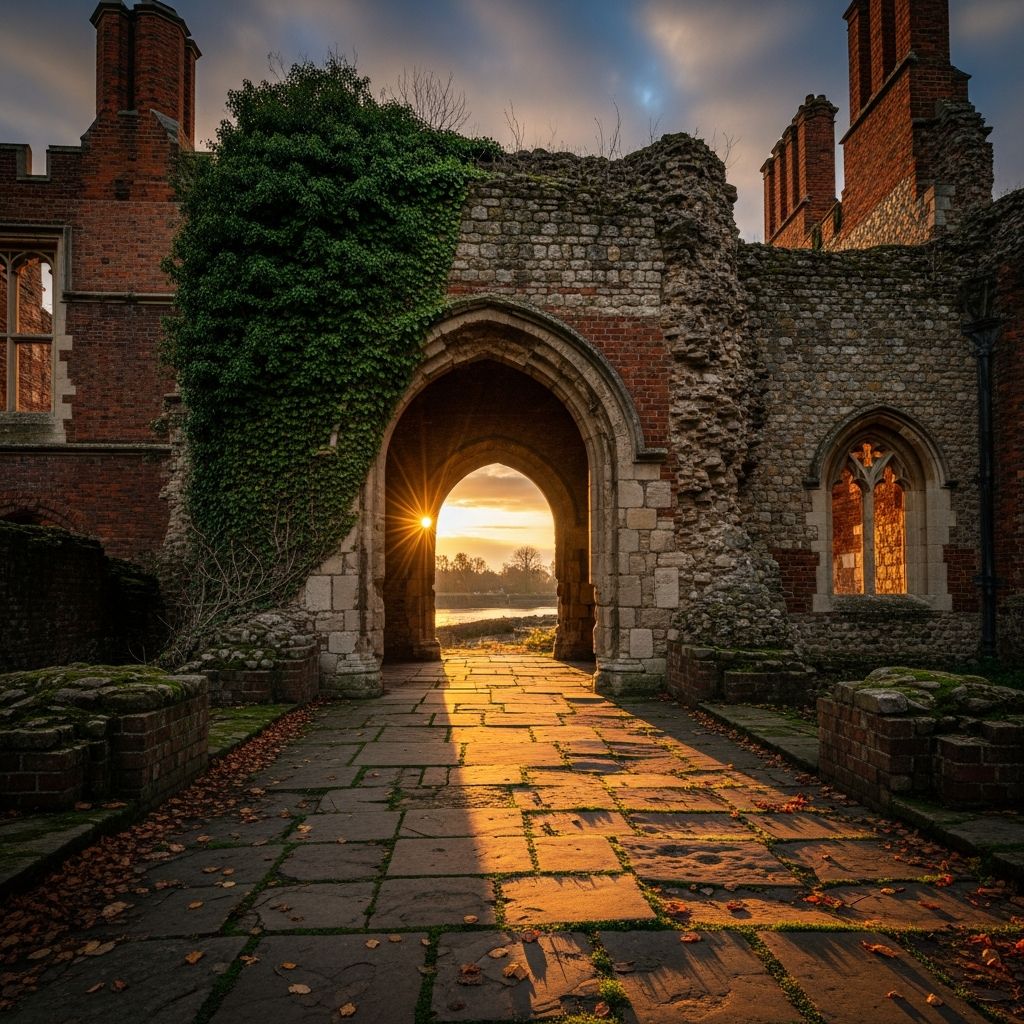Richmond Palace Remains: Tracing the Tudor Legacy
Discover the storied history and surviving secrets of Richmond Palace, a silent witness to Tudor grandeur and royal intrigue.

Between the tranquil banks of the River Thames and the open expanse of Richmond Green lies the echoes of one of England’s most illustrious lost royal residences—Richmond Palace. Revered as a Tudor treasure and the stage for crucial royal dramas, the palace was once among the grand centres of monarchical life, entwined intimately with iconic historical figures such as Henry VII, Henry VIII, and Elizabeth I. Today, Richmond Palace’s remains invite the curious and the scholarly alike to trace its dramatic past amid the architectural fragments that time could not erase.
Overview
- Founded: 1501 by Henry VII on the foundations of earlier royal manors.
- Key Residents: Henry VII, Henry VIII, Elizabeth I, Anne of Cleves, Catherine of Aragon, and more.
- Location: Spanning from Richmond Green to the River Thames.
- Significance: Birthplace and deathbed of rulers, scene of Tudor festivities and tragedy, England’s first flushing toilet, emblematic of Renaissance architecture in English courts.
The Historic Tapestry of Richmond Palace
The origins of Richmond Palace can be traced to the late Middle Ages, with the site evolving from a substantial manor house in 1125 to a royal manor by 1327. Edward I appropriated the manor in 1299, setting the precedent for royal occupation. The structure was originally called Sheen Palace, serving as a country retreat for medieval monarchs. Its true transformation, however, began under Henry VII, who, mourning his son Arthur’s death and seeking a royal seat, initiated its grand reconstruction in 1498. Naming it Richmond Palace—as homage to his former title, the Earl of Richmond—he established a new centre of royal gravity along the riverbanks.
Architectural Grandeur and Innovations
The new Richmond Palace, completed by 1501, stood as a showcase of late medieval and early Renaissance design. Constructed with brick and white stone, it boasted geometric octagonal towers, pepper-pot chimneys, ornate brass weather vanes, and panelled windows that flooded chambers with daylight—a stark departure from older defensive castles.
- The Great Hall: A remarkable hall, 100 feet in length, served as the heart of royal gatherings.
- Long Galleries: Spaces to display art, tapestries, and sculpture, reflecting Renaissance tastes.
- The Royal Chapel and Library: Hubs for spiritual solace and intellectual enrichment.
- Private Royal Apartments: Overlooking lush gardens and the green, offering privacy and prestige.
- Gardens and Orchards: Spanning ten acres, these supplied the court’s table and pleasure walks.
- The First Flushing Toilet: Installed for Elizabeth I by her godson Sir John Harrington, marking a milestone in royal convenience.
Richmond Palace and the English Monarchy
The palace’s corridors bore witness to triumph and turmoil at the heart of the English crown, serving as a residence for several monarchs. Here are the key royal connections:
Notable Royal Residents and Events
- Richard II: The first king to reside at the palace in 1383, devastated after his wife’s death from plague, had the structure destroyed before Henry V revived royal use of the site decades later.
- Henry VII: Built the Tudor palace and died here in 1509. He set the tone for Tudor usage of Richmond as a favoured home.
- Henry VIII: Hosted feasts and hunts, escaped danger as a child, and spent time with multiple wives—Anne of Cleves lived there post-divorce, and Catherine of Aragon stayed for a time. The tragedy of losing a newborn son unfolded here in 1510.
- Elizabeth I: The queen’s favourite palace, where she presided over lavish entertainments and ultimately died in 1603, cementing its place in national memory.
- Mary I: The palace hosted her honeymoon, blending personal and political history within its walls.
Role in Tudor and Stuart Politics
Richmond Palace was more than a royal home; it was a stage for diplomacy, celebration, and political intrigue. Court life flourished in its great halls and gardens, influencing the power dynamics of England for over a century. The palace witnessed marriages, funerals, and the daily governance of empire, described in inventories and accounts that survive in the National Archives.
Palace Life, Entertainments, and Innovations
Life at Richmond Palace was punctuated by ceremonious events, lavish feasting, and remarkable cultural advancements. Elizabeth I, in particular, made use of the palace for diplomatic and cultural spectacles.
Court Entertainments
- Royal Masques and Tournaments: The palace stage hosted elaborate pageants, masques, and martial displays, such as the festivities for French ambassadors in 1564, featuring a castle for ladies and an arbour of knights.
- Banquets and Festivities: The great hall and galleries echoed with music, feasting, and dancing as the court celebrated major occasions.
Richmond Palace stood at the vanguard of both architectural and cultural innovation. Its well-documented inventories reveal rich collections of Italian art, elaborate tapestries, and technological marvels, from ornate clocks to that famous flushing toilet. The palace’s extensive walled gardens and proximity to Richmond Park—a hunting ground for the exclusive use of royal families—further underlined its prestige and extravagance.
The Decline and Demise of Richmond Palace
Despite its centrality to royal life, Richmond Palace’s fortunes shifted with the tides of English history. After the execution of Charles I in 1649, the Commonwealth government under Oliver Cromwell ordered the sale and partial demolition of many royal properties, including Richmond. Its stone and timber were repurposed or sold off, and the palace fell into irreversible decline. Instead of resurrection, the site became a landscape for private homes: revenue-generating rental properties, favored by London’s elite, rose from the royal footprint.
- Civil War Impact: Cromwell’s dissolution of royal structures hastened the palace’s destruction.
- Surviving Fragments: Some Tudor buildings—especially the gatehouse—survived and form the architectural skeleton visible today.
Richmond Palace Remains: What Visitors Can See Today
For those who wander to Richmond Green and follow evocative local street names such as Old Palace Lane and Old Palace Yard, the traces of royal grandeur are still discernible.
Main Surviving Structures and Features
- The Tudor Gatehouse: Dating from 1501, this is the best-preserved portion of the palace. Now a private residence, it retains its original Tudor brickwork. Above the arch, one can inspect Henry VII’s coat of arms, restored in the twentieth century.
- Trumpeter’s House: Built in the early eighteenth century atop the site of the former middle gatehouse, this handsome structure is named for the trumpeter statues that once graced its façade.
- Wardrobe Building: Originally used to house court clothing and regalia, this structure gives a tantalizing hint at the palace’s day-to-day operations.
- Palace Walls and Cellars: Sections of brickwork, garages, and cellars along Old Palace Yard and the Green are remnants of the supporting palace infrastructure.
- Blue Plaques and Information Boards: These guide the visitor to understand the locations’ past prestige and reveal how former courtyards now form tranquil public greens.
| Original Palace Feature | Remains/Modern Equivalent |
|---|---|
| The Gatehouse (Main Entrance) | Still extant, privately owned, visible from street |
| Great Hall, Galleries, Royal Apartments | No longer standing (demolished) |
| Trumpeter’s House | Early C18th house on Tudor site, visible to visitors |
| Wardrobe and Service Blocks | Elements incorporated into modern structures |
| Royal Gardens and Orchard | Now public and private gardens near Old Palace Lane |
How to Find Richmond Palace Today
- Follow Old Palace Lane and Old Palace Yard for the clearest evidence of the palace’s footprint.
- The gatehouse’s imposing arch and the heraldic arms above are open to the view of passersby—though private, respectful visits to observe the architecture are encouraged.
- Information boards and blue plaques mark historical spots and explain their significance.
- Trumpeter’s House, visible from public paths and the Green, stands strikingly on the palace’s old inner gatehouse site.
Richmond Palace in Modern Perspective
While the grandeur of Richmond Palace has been largely surrendered to time and urban development, its legacy endures in local memory, literature, and heritage preservation. The Museum of Richmond offers further context, displaying relics and telling the rich stories of palace life, the people who lived it, and the changes wrought by civil conflict[10]. Periodic archaeological exploration—such as the 1970s excavations—has refined our knowledge, while inventories and maps enable the imaginative visitor to reconstruct the vanished spectacle in their mind’s eye.
- Richmond Palace’s legacy continues to shape the character of the town, with its deer parks, riverside walks, and stately architecture reflecting centuries of regal history.
- The site remains a point of pilgrimage for Tudor enthusiasts, historians, and those seeking a quieter, more reflective connection with England’s royal past.
Frequently Asked Questions (FAQs)
Q: Where exactly is Richmond Palace located?
A: Richmond Palace stood between Richmond Green and the River Thames. Today, its remains and markers are found along Old Palace Lane and Old Palace Yard, Richmond, London.
Q: Can the public visit any parts of Richmond Palace?
A: While public access is restricted since many surviving elements (like the gatehouse) are part of private residences, visitors can walk through the area, observe the gatehouse exterior, see Trumpeter’s House from the Green, and read informational signage installed nearby.
Q: What happened to the rest of the palace after the Civil War?
A: Much of Richmond Palace was demolished and its materials repurposed for building after the English Civil War, particularly in the mid-17th century. Stately homes and gardens replaced royal apartments and halls.
Q: Why is Richmond Palace so significant in Tudor history?
A: Richmond Palace was a principal residence for several Tudor monarchs, notably Henry VII and Elizabeth I. It was a centre for state affairs, art, and innovation, and the deathbed of key historical figures.
Q: What is the best way to learn more about the palace?
A: In addition to visiting the site, the Museum of Richmond provides detailed exhibits, while local history walks and guidebooks elaborately reconstruct its story.
Key Facts at a Glance
- The original palace site spans about 10 acres between Richmond Green and the Thames.
- The site features one of the earliest examples of Renaissance-inspired architecture in England.
- Elizabeth I died here in 1603; Henry VII died here in 1509.
- Although mostly destroyed, the main gatehouse and select buildings provide physical connections to its Tudor glory.
- The palace’s influence persists in the area’s street names and heritage designations.
Further Resources
- Local Museums: The Museum of Richmond curates exhibitions about the palace and the wider region’s history[10].
- Guided Walks: Richmond history tours highlight locations of the former palace and explain their transformations.












